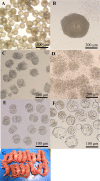Developmental competence of oocytes grown in vitro: Has it peaked already?
- PMID: 26685717
- PMCID: PMC4768772
- DOI: 10.1262/jrd.2015-148
Developmental competence of oocytes grown in vitro: Has it peaked already?
Abstract
In vitro growth of immature oocytes provides opportunities to increase gametic resources and to understand the mechanisms underlying oocyte development. Many studies on the in vitro growth of oocytes have been reported thus far; however, only a few cases have been reported, which demonstrated that oocytes can support full-term development after in vitro fertilization. Our research group recently found that culture of mouse neonatal primordial follicles increased the birthrate; however, the establishment of an in vitro system that can completely mimic follicle or oocyte growth in vivo and control oogenesis remains an ongoing challenge.
Figures


References
-
- Hirao Y. Conditions affecting growth and developmental competence of mammalian oocytes in vitro. Anim Sci J 2011; 82: 187–197. - PubMed
-
- Smitz JE, Cortvrindt RG. The earliest stages of folliculogenesis in vitro. Reproduction 2002; 123: 185–202. - PubMed
-
- Mochida N, Akatani-Hasegawa A, Saka K, Ogino M, Hosoda Y, Wada R, Sawai H, Shibahara H. Live births from isolated primary/early secondary follicles following a multistep culture without organ culture in mice. Reproduction 2013; 146: 37–47. - PubMed
Publication types
MeSH terms
Substances
LinkOut - more resources
Full Text Sources
Other Literature Sources

